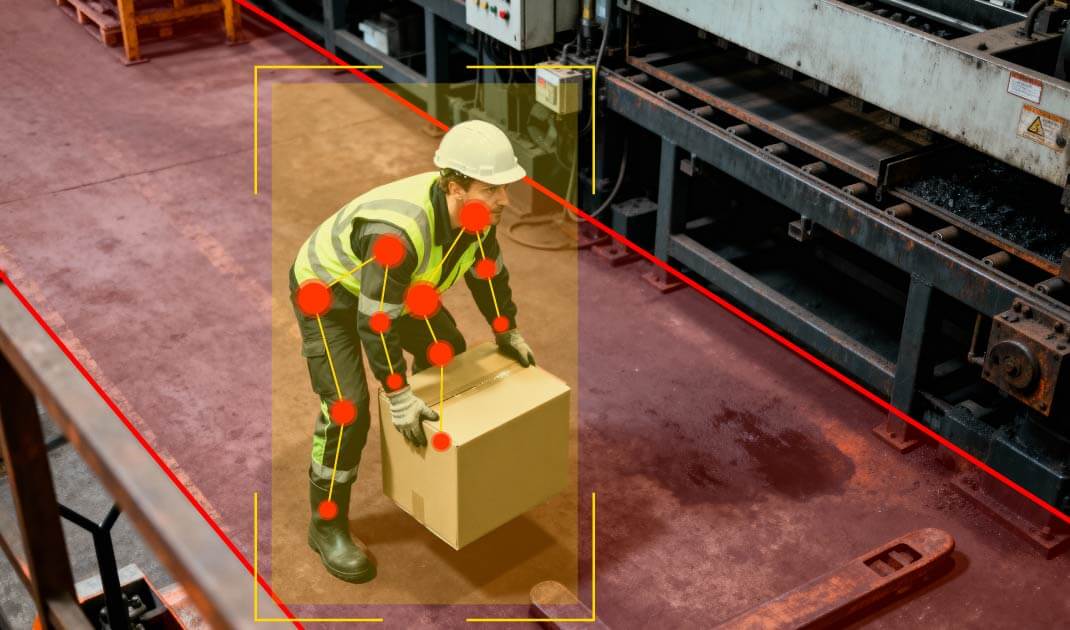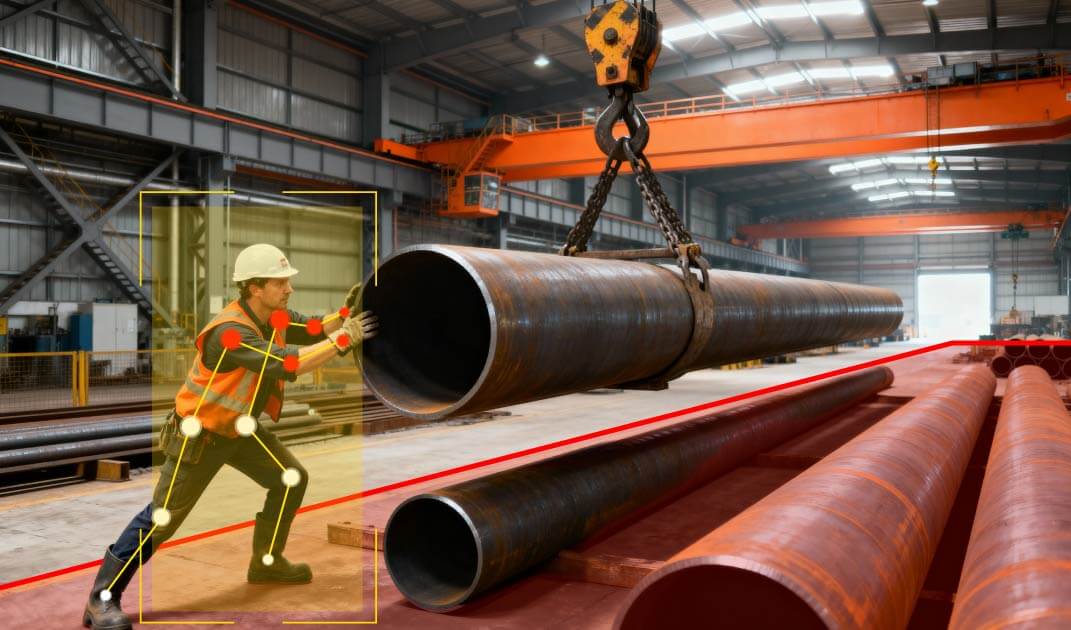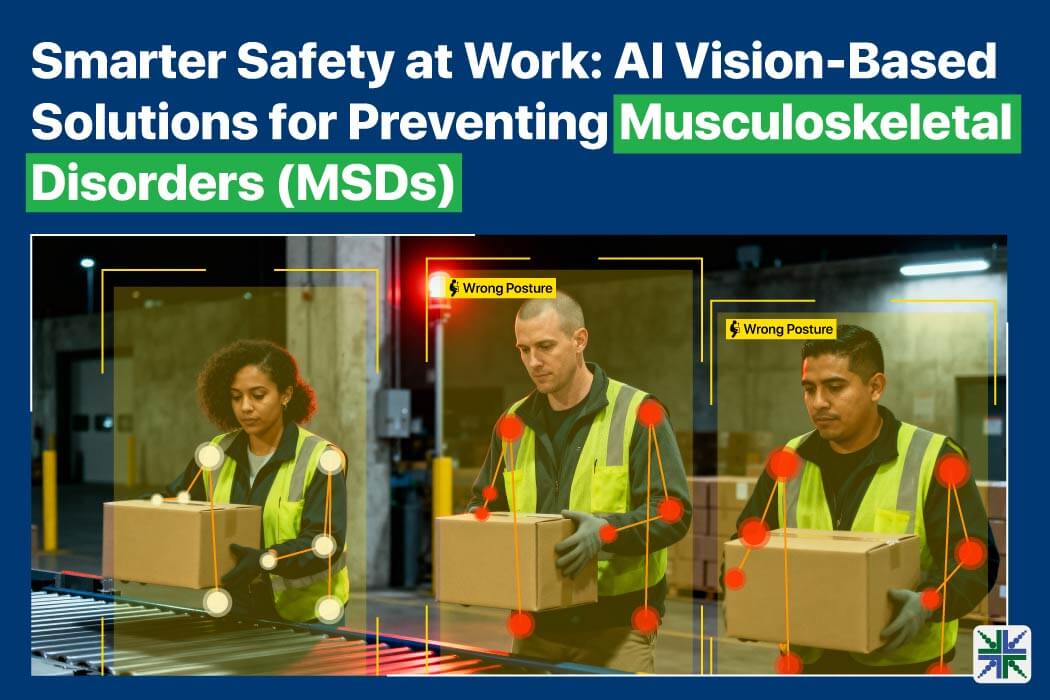What you’ll discover in this blog:
- How MSDs affect employee health/productivity, and workplace efficiency
- The role of AI-powered cameras in real-time posture and movement monitoring
- Key features to look for in Edge AI cameras for safety monitoring
- Practical applications of AI-driven MSDs risk monitoring across industries
Understanding Workplace Musculoskeletal Disorders (MSDs)
MSDs refer to injuries or pain affecting the body’s muscles, tendons, ligaments, joints, nerves, or supporting structures such as the spine. When these conditions arise due to work-related activities, they are known as Work-Related Musculoskeletal Disorders (WRMSDs).
According to EU-OSHA, nearly 75% of workers in Europe experience symptoms such as back pain, neck strain, or repetitive stress injuries.
WMSDs occur due to multiple reasons, but they can often be prevented if identified at an early stage. In the past, supervision or wearable sensors were the primary method for detecting risks — a process that was time-consuming, inconsistent, and often ineffective. WMSDs typically develop over time rather than from a single incident.
A recent report from the Occupational Safety and Health Administration indicates that around 1.3 million workplace injuries occurred over the past year.
Common Workplace Factors Leading to MSDs
- Improper lifting posture
- Frequent or repetitive lifting or carrying of loads
- Prolonged exposure to machinery vibrations or extreme temperatures (hot or cold)
- Extended periods of sitting or standing without breaks
- Repetitive or improper spinal twisting
- Continuous twisting or awkward wrist movements
- Overreaching or working with extended arms
According to the European Agency for Safety and Health at Work (EU-OSHA), MSDs represent around 60% of all work-related health problems across Europe. Similarly, data from the U.S. Bureau of Labor Statistics (BLS) shows that about 900,000 workplace injuries in the private sector led to days away from work, with roughly 30% (over 270,000 cases) involving MSDs in the recent year.
Now, Edge AI cameras offer a solution by monitoring workers’ movements and posture in real-time, delivering immediate alerts when ergonomic risks are identified. These cameras support workers by providing timely feedback and helping maintain safe practices throughout the day.
Hence, industries with physically demanding roles, such as manufacturing, construction, mining, and logistics, can significantly enhance workplace safety. Ultimately, this creates an ergonomically sustainable environment for their workers.
How AI-Driven Cameras Prevent WMSDs
AI-driven cameras leverage computer vision and machine learning to monitor worker posture, repetitive motions, and ergonomic alignment in real-time. These systems identify unsafe movements, quantify risk levels, and provide instant alerts to help correct posture or workflow.
Popular Use Cases of AI Cameras in WMSD Prevention
Posture Analysis for Mobile Elevated Work Platforms (MEWPs): Monitor workers on ladders, scaffolding, or mobile platforms to detect over-extended reaches or forward-leaning back postures.
Lifting Posture Assessment: Analyze load dimensions, lifting angles, and spinal curvature during material handling.

Repetitive Motion Detection: Detect frequent wrist or arm movements using methods like Rapid Entire Body Assessment (REBA) and Rapid Upper Limb Assessment (RULA), alerting workers before fatigue or overuse occurs.

Load Estimation: Approximate the weight of lifted materials and identify unsafe lifting practices
Vibration Exposure Tracking: Monitor exposure to vibrating tools (e.g., drills, grinders) for compliance with hand–arm vibration thresholds
Body Balance and Weight Distribution Analysis: AI cameras posture analysis models estimate weight distribution across limbs and joints during sitting, crawling, squatting, or lifting. The cameras help prevent muscle imbalance and joint fatigue during physically demanding tasks.
Distance and Load Coordination: AI computes object distance, lifting range, and carried load weight, ensuring optimal ergonomic motion paths and reducing strain during transport or installation of heavy components.
Posture Tracking in Confined Workspaces: In restricted or compact work zones, AI cameras detect high-risk body positions, such as deep squats or twisted torso postures that may lead to strain injuries.
Prolonged Standing Assessment: AI monitors static load on the feet and postural stability during long-standing hours.
Spinal Twist and Fatigue Detection: Edge AI cameras recognize abnormal spinal rotations, micro-movements, or early signs of exhaustion at a timely interval to reduce the likelihood of musculoskeletal disorders (MSDs).
Key Camera Features That Enable MSD Risk Mitigation
Low-light performance
Workplaces such as warehouses, factories with night shifts, or cold storage units often operate in poor lighting conditions. Standard cameras may struggle in these environments, leading to inaccurate or missed detections. Low-light cameras address this challenge by precise monitoring in dim environments and consistent imaging performance.
Read: How-low-light-camera-modules-power-critical-embedded-vision-applications
HDR / Wide Dynamic Range (WDR)
In warehouses, some areas may have bright lighting, while others may be dark. Workers in that environment may need to move objects from bright to dark places. A camera with HDR (High Dynamic Range) features can maintain clarity in mixed lighting, providing accurate results in both dim corners and bright areas without compromising image quality.
Read: What is High Dynamic Range (HDR)? How do HDR cameras work?
Global shutter and high frame rates
Workers often perform quick or repetitive movements in workplaces such as assembly lines, logistics centers, or material handling facilities. Global Shutter cameras capture the entire frame at once, eliminating motion blur and distortion.
High resolution
A high-resolution camera captures fine details, such as improper lifting posture, prolonged and poor sitting posture, excessive computer use, or wrist strain from typing, even from a distance. This makes it effective for surveillance in commercial office spaces, factories, warehouses, assembly lines, and logistics centers.
Edge AI computing with low latency
Edge AI-enabled cameras analyze data directly on the device, eliminating the need for cloud processing. This enables real-time risk detection with minimal latency, delivering instant alerts to improve workplace safety.
Rugged IP-rated designs
Rugged, IP-rated cameras are designed to withstand impact, resist dust, and endure vibration and harsh weather conditions while continuously monitoring the posture and movements of workers involved in lifting, bending, or operating power tools in dynamic, high-risk outdoor environments.
Why Choose e-con Systems’ Cameras for WMSD Prevention
Since 2003, e-con Systems has been designing, developing, and manufacturing class-leading OEM cameras that power intelligent workplace safety solutions. Our edge AI-enabled cameras are ideal for ergonomic monitoring, preventing WMSD, ensuring PPE compliance, and automating industrial safety.
With features such as high resolution, superior low-light performance, and global shutter technology, they ensure round-the-clock accuracy in demanding environments.
Browse our Camera Selector Page to check out our full portfolio.
For guidance on finding the best-fit camera solutions, contact us at camerasolutions@e-consystems.com.
FAQs
- How do Edge AI cameras detect ergonomic risks?
AI-powered cameras analyze worker posture and movements in real-time using edge AI algorithms. They apply ergonomic assessment models to identify risky behaviors, such as improper lifting, repetitive motions, or unsafe bending. - Can these cameras distinguish between regular movements and unsafe postures?
The cameras are trained to recognize task-specific movement patterns, filtering out everyday actions while flagging postures that exceed safe limits. Depth sensing and high-resolution imaging improve the accuracy of posture detection. - Do these cameras work in low-light or harsh environments?
Cameras designed for workplace safety come with HDR, low-light sensors, global shutter, and IP-rated rugged designs, ensuring reliable monitoring even in dim lighting, dusty conditions, or extreme temperatures. - Can these cameras provide actionable insights for workplace redesign?
AI cameras generate detailed reports highlighting high-risk tasks, zones, or repetitive movements. Companies can use this data to redesign workstations, optimize workflows, and improve training programs. - How do Edge AI cameras maintain data privacy in workplace monitoring?
Edge AI systems process data locally on the device, rather than in the cloud, ensuring that sensitive visual information remains within the organization’s network and minimizes privacy risks.

Ram Prasad is a Camera Solution Architect with over 12 years of experience in embedded product development, technical architecture, and delivering vision-based solution. He has been instrumental in enabling 100+ customers across diverse industries to integrate the right imaging technologies into their products. His expertise spans a wide range of applications, including smart surveillance, precision agriculture, industrial automation, and mobility solutions. Ram’s deep understanding of embedded vision systems has helped companies accelerate innovation and build reliable, future-ready products.




